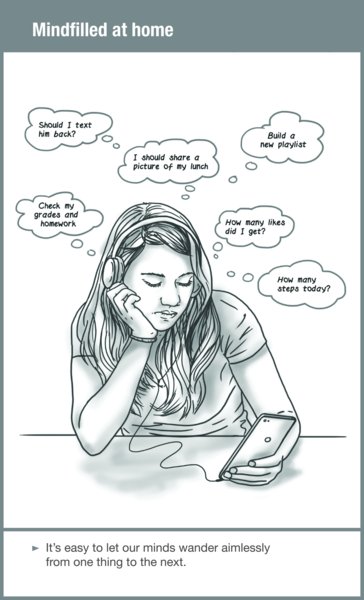Chapter 5
Always Stuck at School
While I shared with people the motivation behind this book, several have divulged some startling stories with me. Such is the case with my friend Bryan, who thought he lost his teenage daughter to depression.
Bryan and his wife Anna seemed to have model children. Their son and daughter are overachievers by anyone’s standards. They do well in school, have tons of friends, and are well adjusted.
Or so Bryan and Anna thought, until their daughter Monica, the younger of the two children, was a junior in high school and started missing school. She refused to go and even stopped wanting to get out of bed.
Anxiety and depression had engulfed her. It was bad. She missed so much school that she was on the edge of failing out. There was no sign she was ever going to go back. Her parents felt helpless, looking for reasons.
Monica would isolate herself in her room each day not doing anything. She wouldn’t read, wouldn’t check social media, wouldn’t watch TV.
As soon as this started, Bryan and Anna got her into therapy and tried everything they could to help their daughter. Nothing was working. They thought they were losing her.
Serious Triggers
In desperation, they sent her to a private girls’ school in the Northwest that focused on helping girls with addictions, behavioral problems, and other trauma. At the school, the students were completely unplugged from social media and technology. There were consequences for failing to follow the rules, and it was a very structured environment.
Monica’s time at the new school saved her life. She surfaced from the depression and now has more energy and focus because she has rules and strategies to control her behavior. Going back to her previous school was only possible because she was able to break the cycle.
It seems that social media was a powerful, primary trigger for her depression.
At any moment of any day she felt pressured to be “always on”—sharing updates, photos, liking posts, and counting how many days she was on. She couldn’t escape it. It was like she was in school all day long. Her identity was wrapped up in connecting with her peers all day. The irony is her constant connectedness created isolation. Monica spiraled down into a terrible anxiety and depression cycle where she felt completely paralyzed.
New Protective Behaviors
The last time I spoke to my friend, his daughter was coming home from the school. But before she could come back and resume her life, she had to make a personal plan to handle everyday teenage situations, like what she would do when her friends would go out to eat and they’d all be on their smartphones using social media.
How would she resist this behavior? How was she going to cope when her peers are almost always plugged in? How would she say no and set boundaries?
Before this all happened, Monica was always on social media, connecting with people, commenting on their posts, and posting herself. The pressure to make everyone “like” her posts and to present an exciting portrayal of her life was overwhelming. It turns out this created a massive wave of depression and anxiety for her.
She was absolutely miserable. Once they learned what was wrong with Monica, Bryan and Anna realized they enabled her behavior, thinking all that time spent glued to her phone wasn’t harmful but part of being a modern teen.
Terrified Parents
What’s frightening for parents is that what happened to Monica is happening to other children with alarming regularity. And with the predictions that access to technology will only increase in the future, parents will have to be vigilant to protect their kids.
In past generations, when students left school, they also left behind anxieties or stress related to their classes. There was a separation. Not anymore.
One of my sons tells me, “Dad, we’re always at school because we’re connected to the technology even when we’re at home.” He’s right and it’s a reality.
All those comments, likes, shares, and posts make our children feel like they constantly have to keep up to be “on” and be accepted. They feel stuck at school with:
- Online homework postings and assignments
- Discussion boards where students must be online and interact to complete assignments
- Teacher e-mails and homework posts
- Online books and articles
- Reliance on laptops, even in the elementary school
- Persistent, online bullying (you can’t escape the playground bully—even at home)
- Negative online posts and taunts from other schools/students regarding athletic teams and other activities
Disturbing Statistics
What makes kids so vulnerable to technology addiction is that their brains are still developing. We know that teens have underdeveloped impulse control and empathy judgment. Their brains are incredibly malleable and able to change to their environments.
They also have what neurologists call “a hyperactive risk-reward system” that makes them susceptible to addiction.

The part of our brains that helps us to focus and understand human emotion doesn’t completely develop until well into our twenties, says Paul Atchley, a professor of psychology at the University of Kansas.
“During our teenage years, it’s important to train that prefrontal cortex not to be easily distracted,” Atchley said in a Time magazine interview. “What we’re seeing in our work is that young people are constantly distracted, and also less sensitive to the emotions of others.” This training, though, may seem like a daunting task when kids are hindered by these technological distractions.1
Our Children in Isolation
Any person just looking around can see how technology is making our kids more isolated. You see groups of kids in a restaurant or in a park, and they aren’t talking to each other, at least not verbally interacting or making eye contact. Their heads are down, and their fingers are quickly moving over their screens.
Most of what people post on social media are positive things, yet they contribute to young people’s anxiety and depression. No one wants to look bad or ridiculed. They’re not sharing the difficulties of adolescence but are trying to keep up and look good. This fuels the desire, especially among adolescent girls, for acceptance, for the need to be “perfect” and FOMO (the fear of missing out). You have to stay on and keep up or you get left behind.
That’s hurting our children.
Between 2010 and 2016, the number of adolescents who experienced at least one major depressive episode leapt by 60%, according to the US Department of Health and Human Services (DHHS). Depression is certainly on the rise. In a 2016 survey of 17,000 kids, the DHHS also found that about 13% of adolescents had a major depressive episode, compared to the 8% reported in 2010.2
The rate of suicide is also increasing among people age 10 to 19, according to the Centers for Disease Control and Prevention. Young women are suffering most.3

A study by San Diego State University “found that kids who spent three hours or more a day on smartphones or other electronic devices were 34% more likely to suffer at least one suicide-related outcome—including feeling hopeless or seriously considering suicide—than kids who used devices two hours a day or less. Among kids who used electronic devices five or more hours a day, 48% had at least one suicide-related outcome.”4
Is It Addiction?
Although medical professionals debate whether teens overusing social media or video games can be labeled an addiction, they agree that overuse can have adverse effects on young people.
Dr. Michael Bishop, who runs Summerland camps for young people ages 10 to 18 who have video game or technology addictions, told National Public Radio that teens who come to him fall into two broad categories: (1) those who spend so much time playing video games that they lose their social skills, and (2) those who overuse social media, who are most often girls.5
The kids into gaming are most often boys, and they often suffer from depression or anxiety.
It’s a scary situation and will only get worse.
Rewind
- Do you ever notice that your child is always looking at a screen? When you ask them to put it away and spend time with you or the family, do they argue with you that you’re overreacting or argue that all of their friends are online at the same time? Do they claim that they are doing schoolwork, but then you see them playing games or checking social media?
- Have you started noticing your child no longer meets up with friends or has friends over? When you ask them why, do they become aggressive, saying they are meeting with their friends online?
- Have you noticed that after you’ve confiscated your child’s phone or device in order to get them away from the screen, they become edgy, aggressive, or withdrawn? Have you found them secretly using your phone or their siblings’ device?
- Have you considered the effects of your own phone habits on your children’s behavior?
[Brief Recap]
There’s an alarming rise in anxiety and depression for teens, much triggered by the always-on, addictive nature of smartphones and social media. Our youth feel constantly connected to digital devices, yet more isolated from each other at a time in their lives where they need to develop personally, socially, and emotionally in healthy ways.
{Tune-in}
We need to have a heightened awareness of the behavioral impact that constant connectivity has on our kids and find practical ways to protect (and disconnect) them.
